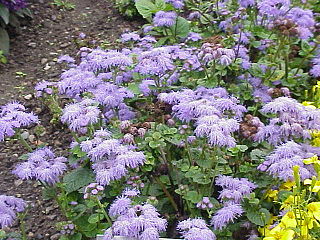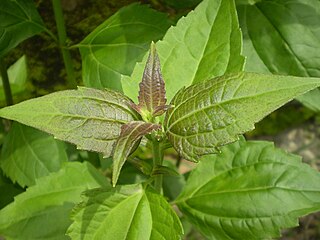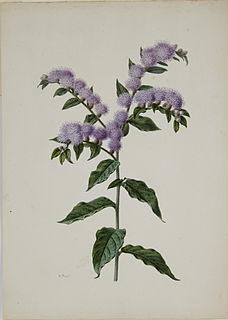
Salpiglossis sinuata, the painted tongue, scalloped tube tongue, velvet trumpet flower, palito amargo or panza de burro ( Spanish : donkey's paunch ), is a flowering plant belonging to the subfamily Cestroideae of the nightshade family Solanaceae, native to southern Chile.

Eupatorieae is a tribe of over 2000 species of plants in the aster family. Most of the species are native to tropical, subtropical, and warm temperate areas of the Americas, but some are found elsewhere. Well-known members are Stevia rebaudiana, a number of medicinal plants (Eupatorium), and a variety of late summer to autumn blooming garden flowers, including Ageratum (flossflower), Conoclinium (mistflower), and Liatris.

Chromolaena odorata is a tropical and subtropical species of flowering shrub in the family Asteraceae. It is native to the Americas, from Florida and Texas in the United States south through Mexico and the Caribbean to South America. It has been introduced to tropical Asia, West Africa, and parts of Australia.

Dimorphotheca sinuata, the glandular Cape marigold, Namaqualand daisy, or orange Namaqualand daisy; syn. Dimorphotheca aurantiaca hort.) is an African species of plants native to southern Africa. It is also widely cultivated as an ornamental and naturalized in parts of the United States, primarily California and Arizona.

Chromolaena is a genus of about 165 species of perennials and shrubs in the family Asteraceae. The name is derived from the Greek words χρῶμα (khrôma), meaning "color", and χλαῑνα (khlaīna) or λαῑνα (laīna) meaning "cloak". It refers to the colored phyllaries of some species. Members of the genus are native to the Americas, from the southern United States to South America. One species, Chromolaena odorata, has been introduced to many parts of the world where it is considered a weed.
Tamaulipa is a genus of flowering plants in the boneset tribe within the sunflower family.

Cyrtocymura is a genus of Latin American and Caribbean plants in the evil tribe within the daisy family.

Chromolaena ivifolia called ivy-leaf false thoroughwort, or ivyleaf thoroughwort, is a species of flowering shrub in the family Asteraceae. It is native to North America and South America, from the south-eastern United States to Argentina.
Chromolaena frustrata called Cape Sable false thoroughwort, or Cape Sable thoroughwort, is a rare North American species of flowering shrub in the family Asteraceae. It is found only in southern Florida, on the Florida Keys, inside Everglades National Park, and other nearby low-lying areas. It grows on coastal rock outcrops, the edges of hammocks, and other undisturbed sites at elevations less than 10 meters above sea level.
Chromolaena bigelovii called Bigelow's false thoroughwort, or Bigelow's thoroughwort, is a North American species of flowering shrub in the family Asteraceae. It is native to northeastern Mexico and the US State of Texas.
Chromolaena borinquensis, the limestone thoroughwort, is a West Indian species of flowering shrub in the family Asteraceae. It is native to the Commonwealth of Puerto Rico, part of the United States.
Chromolaena geraniifolia, the geraniumleaf thoroughwort, is a West Indian species of flowering shrub in the family Asteraceae. It is native to the Commonwealth of Puerto Rico, part of the United States.
Chromolaena hirsuta is a South American species of flowering shrub in the family Asteraceae. It is native to Brazil, Bolivia, Uruguay, and Argentina.
Chromolaena oteroi, the Mona Island thoroughwort, is a species of flowering shrub in the family Asteraceae. It has been found only on Mona Island, a small island between Puerto Rico and Hispaniola in the West Indies and politically a part of the Commonwealth of Puerto Rico.
Chromolaena trigonocarpa is a rare Caribbean species of flowering shrub in the family Asteraceae. It is found only the Island of Dominica in the Lesser Antilles.
Chromolaena integrifolia is a Caribbean species of flowering shrub in the family Asteraceae. It is found on the Islands of Dominica, Guadeloupe, La Desirade, Les Saintes, Marie Galante, Montserrat, and St. Kitts in the Lesser Antilles.
Chromolaena squalida is a South American species of flowering shrub in the family Asteraceae. It is found in Brazil, Paraguay, Bolivia, Peru, Colombia, Venezuela, Guyana, Suriname.
Chromolaena sagittata is a Mexican species of flowering shrub in the family Asteraceae. It is found in western Mexico, in the states of Sonora, Sinaloa, Nayarit, and Baja California Sur.
Koanophyllon villosum, the Florida Keys thoroughwort, or abre camino, is a species of flowering plant in the family Asteraceae. It grows in southern Florida, Cuba, the Bahamas, Hispaniola, Jamaica, and the Islas de la Bahía.
Koanophyllon droserolepis, the Monte Torrecilla thoroughwort, is a species of flowering plant in the family Asteraceae. It is found only in Puerto Rico.






